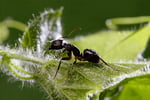Subterranean Yellowjacket Nest
Every month, Hamilton Allen our Director of Technical Services and Training will be sharing information on a variety of relevant topics with the goal of providing helpful information for common issues that arise throughout the year. This month Hamilton is covering a frequent fall pest problem, yellowjackets.
Yellowjacket populations are at their peak during the late summer and early fall with nests containing hundreds to thousands of workers as well as female and male reproductives. The male and female yellowjackets leave the nests to mate and soon after mating, the male yellowjackets dies! On the other hand, females fly off and begin looking for locations to overwinter. One thing to note is that the only overwintering individuals are female reproductives. They provide the life of the colony and because she has already received the male's contribution, he will not be needed going into the winter and spring. Developing yellowjackets feed on solid foods such as insects, carrion, and other foods containing high amounts of carbohydrates. Carbohydrate is a general term given to sugars, starches, and structural plant materials. The carbohydrates are utilized by the female reproductives to assist them with overwintering and brood support when they emerge in the spring. Yellowjackets primarily build subterranean nests but will also build aerial nests. However, the majority of aerial nests are created by bald-faced hornets. Although yellowjackets reside in subterranean nests, overwintering underground can sometimes bring a "chilling" death. In an effort to overwinter, females begin seeking warm harborages and will attempt to invade structural voids, attics, or any suitable structure.
For yellow jacket control services call 877-944-4007
Author: Hamilton Allen - Director of Technical Services and Training










